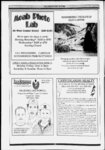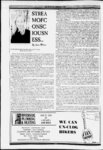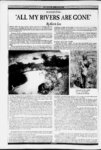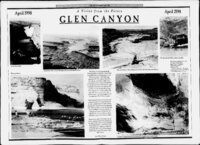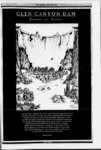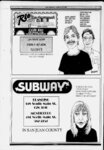| OCR Text |
Show other game fish In Reservoir Pbwell. Is it a problem? Well, EPA and the Fish fe Wildlife Service seem to think so when issue advisories on how much fish flesh they to consume. Will this cause catastrophic impacts in the Colorado River? Not likely at the present rates, but who knows? Bioaccumulation can occur at rates that have secondary effects that we don't totally understand yet. There is valid concern over what would occur to the demographics and economy of Page. The town was developed on land acquired in a trade with the Navajo Nation in the 1950 s and was developed as a government and contractor town. Over the years it has developed and incorporated around an economy that is largely driven by Reservoir Powell summer recreation and the Navajo Generation Station. Clearly there would be a change in the recreation demographics of the area. Recreation would change from speedboats and jet skis to one defined by rafting, and The canoeing, hiking biking. type of recreation would change but the economics of the area would evolve and survive. There has also been concern that the coal fired power plant outside Page, the Generation will Station, have close to Navajo down. The power plant is not dependent on the reservoir except for cooling water. The cooling could be accomplished by other means. It does not depend or need Glen Canyon dam to survive. Its existence is there because the people decided in 1968 that they did not want more dams in the Grand Canyon. Its location is defined its access to Black by Mesa coal and the electrical distribution market to Central Arizona. That will not change. Glen Canyon Dam will not last forever. An interesting and troubling fact is that Glen Canyon, and more than 750 other federal dams in the United States, have-ndecommissioning language. In other words, the government built these dams without any forethought. What will be done with them once they reach their life span? Today the Department of Energy is decommissioning nuclear power plants and the Federal Energy Regulatory Commission is decommissioning private dams. What is being done about the dams that Reclamation or the Corp of Engineers has built? mega-houseboa- year period of time. Environmental resources will emerge and the biological integrity of Glen Canyon will be reestablished. Will the river and canyon return to what it looked like in 1869? Of course not Those days are gone. Too many people, upstream constraints, exotic species and water quality problems exist What we are striving for is the restoration of the physical processes that define a river. Processes that over time will restore riverine habitats. With that will come the reestablishment of the biological processes and resources. Native species will have an opportunity to reestablish their presence and species will continue to be present though in much reduced integrity. Non-natinumbers. They are not built to survive in the dynamic nature of the unconstrained Colorado River. 10 ve ts, A Pipe Dream or a Dream of Substance? Without a vision of the future we are constrained to continue on the existing path of natural heritage loss. We are at a critical juncture in the road. One route takes us -down the short-terpath of continuation and environmental capitulation continuation of the loss of resources and an unsustainable future. The other path, though longer and more circuitous, and full of speed bumps, leads to a sustainable environmental future. A future with the heart of the Colorado River ecosystem restored. The Glen Canyon Institute and thousands of people across the country and around the world are willing to stand up and demand that the decision made to drown Glen Canyon in 1956 be revisited. We are not required to continue down a road of decisions that do not make environmental sense today. If we as a people were not allowed to revisit the past, then many of the basic freedoms of choice that we so enjoy today would never have come to pass. The time is here; the time is now to ask the question. Free the river, restore Glen Canyon! m My God , What a Stinking Mess Would be LeftI The Glen Canyon Institute is proposing a slow, scientifically coordinated draining of Reservoir Powell, a drainage plan that would follow the seasonal and annual hydrology to slowly bring down the level of the reservoir. Catastrophic draining of the reservoir would be bad for both Glen and Grand Canyon biological resources. GCI is proposing a drainage plan that would take 10 to 15 years to complete. Over the years the water would slowly drain out of the sandstone and sediments, moving the sediments from the side canyons and delta and transporting the water and sediment slurry downstream. As the sediments become exposed, they will be eroded and transported into the main channel and either moved downstream or provide substrate for the revegetation of plants. Experiments and studies conducted in the Grand Canyon during the 1996 experimental flood found that if the timing is right, native plants could the non-natitamarisk and other species,; The springs that have been drowned would be and revitalized by native plants and species supplied from other areas in the watershed. I( is proposed that as the waters drop each year, conservation groups, public groups, the Presidents Youth Conservation Corps, and others are employed to pick up the exposed trash and aluminum. There may be a gold (aluminum) mine in cans alone! Experienced people and contractors would handle heavier objects (i.e. boats, motors, jet skis, batteries, etc.). The beauty and biological integrity of Glen Canyon will slowly emerge as the waters of the reservoir drop. There will be seasonal ups and downs in water levels for several years but the trend and intent is to get back to a river in a time frame that will allow for the greatest good for the resources. Evidence already gathered from backcountry rangers and conservationists have documented the water level variations in side canyons, indicate that within a year or two the side canyons will flush themselves clean of sediment and the white "bathtub ring will be gone within a 5 to out-comp- Fools! You Fools! SUBSCRIBE TO THE ZEPHYR NOW. You Dcatails on page 3 ete ve BROWNTROUT PUBLISHERS P.O. Box 280070 San Francisco. CA 94128-007- 0 800-777-78- www.browntrout.com 12 Browntrout was founded in 1986 as a book and calendar publisher. Our success with calendars (almost 500 titles in 1998 the largest in the country) has kept usr very busy. In 1994 we launched our book program. The books we publish fall into two categories: photographic portfolios and trade books. Look for many of our books and calendars at: B. Osborn Books 6r Back of Beyond in Moab or call us direct 59" Matt IT A ' v : V ' |





